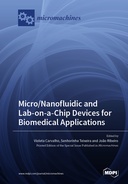Explore

Micro/Nanofluidic and Lab-on-a-Chip Devices for Biomedical Applications
0 Ungluers have
Faved this Work
Login to Fave
Recently, microfluidic, nanofluidic and lab-on-a-chip devices have gained particular attention in biomedical applications. Due to their advantages, such as miniaturization, versatility, ease of use, cost-effectiveness, and the potential to replace animal models for drug development and testing, these devices hold tremendous potential to revolutionize the research of more effective treatments for several diseases that threaten human life. With integrated biosensors, these devices allow the development and design of micro- and nanoparticles to be studied in detail, modelling human physiology, investigating the molecular and cellular mechanisms underlying disease formation and progression, and gaining insights into the performance and long-term effects of responsive drug delivery nanocarriers. This Special Issue gathered research papers, and review articles focusing on novel microfluidic, nanofluidic and lab-on-a-chip devices for biomedical applications, addressing all steps related to fabrication, biosensor integration and development, characterization, numerical simulations and validation of the devices, optimization and, the translation of these devices from research labs to industry settings.
This book is included in DOAB.
Why read this book? Have your say.
You must be logged in to comment.
Rights Information
Are you the author or publisher of this work? If so, you can claim it as yours by registering as an Unglue.it rights holder.Downloads
This work has been downloaded 127 times via unglue.it ebook links.
- 127 - pdf (CC BY) at Unglue.it.
Keywords
- additive manufacturing
- artificial intelligence
- Automation
- bacterial population dynamics
- biochemical assay
- biochemical stimuli
- Biocompatibility
- biophysical stimuli
- cancer-on-chip
- capillary
- cell trap
- colorectal cancer
- computational fluid dynamics
- computational simulations
- cortical neurons
- COVID-19
- Diagnosis
- DNA amplification
- Drug Discovery
- drug efficacy
- E. coli
- electrical stimulation
- embedded resin
- engineered neuronal networks
- evaporation
- evolutionary algorithm
- Ex vivo
- fluorescence
- focus drifting
- Generative design
- hippocampal neurons
- Histology
- Hydrogels
- Image analysis
- immersion oil viscosity
- immunoassay
- in vitro cell culture
- in vivo micro bioreactor
- l-DNA
- lab-on-a-chip
- label-free detection
- Lactate
- live cell imaging
- Liver disease
- liver-on-chip
- long-term microscopy imaging
- medicine
- Micro-Electrode Arrays
- microarray
- microchannels
- microfabrication
- microfluidic
- microfluidic biochip
- microfluidic cassette
- microfluidic device
- microfluidic devices
- Microfluidics
- microphysiological system
- mother machine
- multi-level microfluidic device
- multiplex measurement
- n/a
- non-enzymatic
- Numerical simulations
- organ-on-a-chip
- organ-on-chip
- osmotic pumping
- oxaliplatin
- paper microfluidics
- PCR
- peptide aptamers
- peptide biosensor
- Pharmacodynamics
- pharmacokinetics
- point-of-care testing
- poly-(ethylene glycol)-diacrylate
- polydimethylsiloxane
- preclinical models
- protein biomarker
- protein biomarkers
- RBC
- SARS-CoV-2
- sectioning
- Sensing
- single-cell studies
- small intestine
- sweat
- troponin T
- wicking
- xenograft
Links
DOI: 10.3390/books978-3-0365-6099-1Editions

